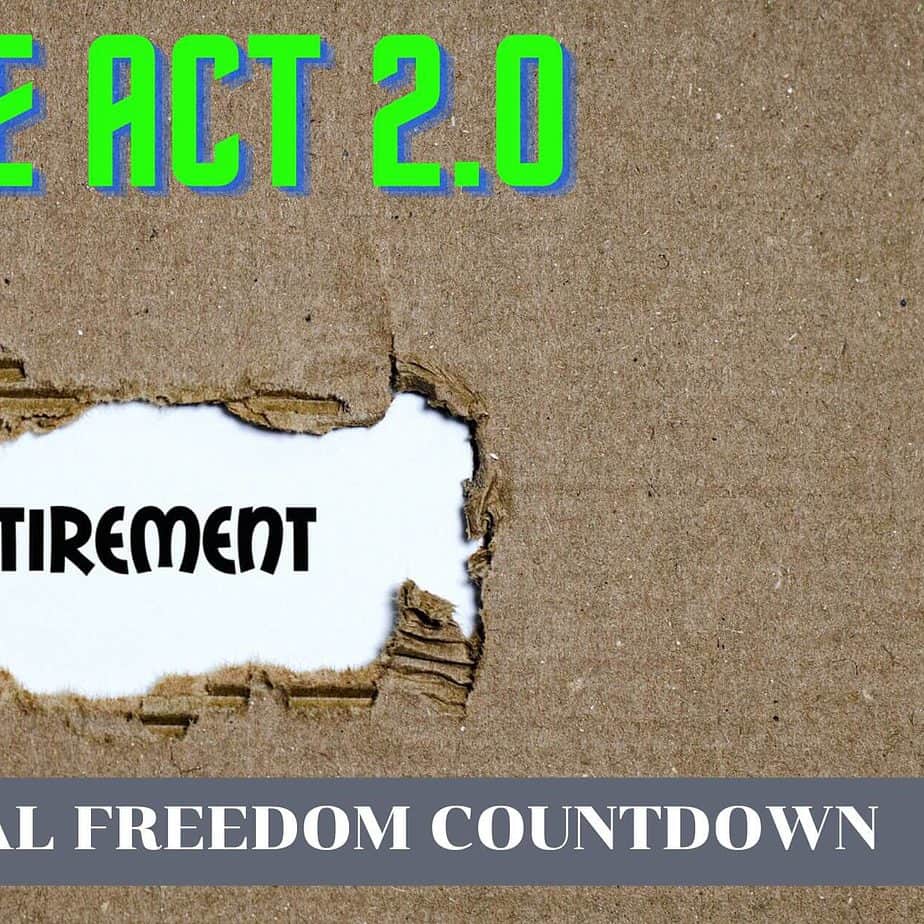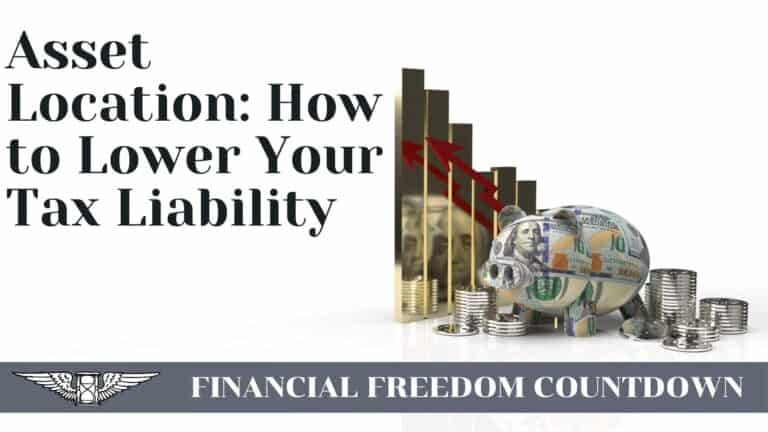SECURE ACT 2.0: How the New Legislation Could Impact Your Retirement

“SECURE 2.0” was passed as part of the $1.7 trillion spending bill on 23rd December 2022. Since we know that Congress is not fiscally responsible, let us ignore the larger spending bill and focus on how the SECURE Act 2.0 provisions buried in the 4,100-page bill impact our personal finance.
SECURE Act 2.0 is an effort to build upon the successes of the SECURE Act passed in 2019, striving to give more employees access to retirement plans and other benefits. Now, three years after this pioneering legislation altered our national retirement system for the first time in over ten years, we look forward to additional changes that will create even greater security and financial stability.
Several provisions mandate automatic enrollment in specific workplace plans, allow for higher “catch-up” contributions from older workers and expand access to retirement plans for part-time employees. Additionally, these measures will increase employees’ capacity to save emergency funds and facilitate their ability to gain access quickly should a crisis arise.
What Is the SECURE Act 2.0?
Some of the many provisions that are in the massive appropriations bill include:
Automatic 401(k) and 403(b) Enrollment
Starting in 2025, employers will be mandated to automatically enroll their employees in 401(k) and 403(b) plans with a rate of at least 3% but at most 10%. This automatic contribution rate should progressively increase by 1% each year until it reaches at least ten but at most 15% for the employee’s wages.
A worker can contribute more if they choose to, as long as it does not exceed any other imposed limits.
Small businesses with a staff of 10 or fewer and fledgling companies in operation for no more than three years are excluded from the mandate.
Overall the provision is a net positive since automation of savings or investing has been shown to improve participation. One of the many reasons I favor investment platforms like M1Finance, which lets you automatically invest in stocks with no fees for as low as $10/week. Read my M1Finance review on why I recommend them over larger brokerage firms.
Also, the 401(k) is an excellent retirement tax-saving vehicle. It is possible to retire early with only a 401(k).
Increased RMDs Age
The bill will raise the minimum required withdrawal age from 72 to 73 in 2023 and then again to 75 by 2033. Unfortunately, those already receiving Required Minimum Distributions (RMDs)will not be exempt from this law change.
Many seniors are living longer, and some are even taking up low-stress retirement jobs to supplement their income and keep themselves engaged. Postponing the RMDs will let compound interest work its magic on their nest egg.
Individuals who have leveraged their human capital in 7 figure jobs will often accumulate a lot of money in pre-tax accounts. The amount of RMDs could impact individuals for Social Security or Medicare.
One of the advantages of planning to retire early is the longer time frame to convert IRAs and 401(k)s into Roth. The increased RMD age provides additional choices for retirement distribution.
Penalty Lowered for Missed RMDs
With SECURE Act 2.0, you won’t have to worry as much about accidentally missing your required minimum distribution (RMD). Instead of the previous 50% penalty for forgetting an RMD on time, you will only pay 25%. If you discover and correct your mistake after the fact, the punishment is even lighter – just 10%!
A small change that goes a long way in protecting your financial security. The current RMD penalty rules were draconian, so Congress has stepped in to reign in the severe penalties.
Understanding the RMD rules and lowering your pre-tax account balance is part of planning how to FI.
RMD Rules for Roth 401(k)s Changed
Although Roth IRAs currently possess no RMDs for the original account holder, that is not necessarily true for Roth 401(k)s. Fortunately, this requirement will be removed starting in 2024 and onward, allowing more people to benefit from these accounts without worrying about pre-death distributions.
While this is a welcome benefit, there are still reasons to evaluate traditional 401(k) vs. Roth 401 (k) based on your circumstances.
Matching for Roth Accounts
Employers can now give their workers the choice of receiving vested matching contributions to Roth accounts, a remarkable difference from the pre-tax basis for matches in employer plans.
Contributions to a Roth retirement plan are taxed before funds enter the account; however, all earnings grow tax-free after that point!
Higher “Catch-Up” Contributions for Older Workers
With the current law, you can add an additional $6,500 annually for 2022 and $7,500 for 2023 into your IRA, 403(b), or 401(k) after age 50.
However, SECURE 2.0 plans to make it even better. Starting in 2025, any savers between the ages 60-63 will have increased limits to the greater of $10,000 or 50% more than the regular catch-up amount.
What’s more? All catch-up contribution limits will adjust with inflation. Also, catch-up contributions will receive the Roth treatment (tax-free growth and withdrawal) except if you earn $145,000 or less!
More Employer 401(k) Match Options
Employer matching contributions kick in only when the employee contributes to the 401(k). Unfortunately, many employees need more money to pay off student loans and contribute to their 401(k). Consequently, these employees skip 401(k) contributions and lose the employer match.
The new provision permits employers to consider qualified student loan payments equivalent to 401(k) contributions making them eligible for the match.
Access to Emergency Savings
Beginning in 2024, individuals under 59 1/2 can withdraw up to $1,000 from their retirement account for emergency expenses without the customary 10% tax penalty on early withdrawals. Nonetheless, penalties may apply if you do not replenish these funds within three years and require another withdrawal due to a similar circumstance.
Companies may allow their employees to set up emergency savings account through automatic payroll deductions, with an upper limit of $2,500 per annum and the first four withdrawals in a year free from taxes and penalties.
With the right plan rules in place, contributions may be qualified for employer matching. Not only does this provide participants with penalty-free access to funds, but an emergency savings fund can also encourage them to save up for urgent and unforeseen expenses.
Part-Time Workers’ Access to Retirement Accounts
The original SECURE Act demanded that companies offer their 401(k) to part-time staff who worked 500 to 999 hours for three consecutive years. With SECURE 2.0, this period has been reduced to two years! Furthermore, employers must make the 401(k) available if employees log 1,000 hours or more annually.
Federal Matching Contribution for Lower-Income Retirement Savers
The 50/30/20 budget rule works excellent for retirement savings as long as you earn a decent income. However, with low-income earners, saving for retirement takes a lot of work to add to their budget template.
To incentivize retirement savings among low- and moderate-income individuals, the government is providing a Saver’s Match Program. Under this program, taxpayers can receive a 50% match on up to $2,000 of their annual retirement contributions.
More than 108 million US citizens could be eligible to take advantage of the Saver’s Match that can directly deposit funds into their retirement account, creating an opportunity for moderate-income earners to boost their retirement savings significantly.
Unused 529 Funds
Families and students are hesitant to fund their 529 accounts to the necessary levels required for educational expenses due to fears of non-qualified withdrawals resulting in penalties leaving excess funds trapped. Consequently, this has resulted in a delay or even refusal to contribute towards paying the increasing cost of education.
And the latest executive orders for the forgiveness of student loan debt have made 529 plan contributions quite unattractive.
The new proposed provision will permit individuals to roll over and transfer up to $35,000 from their 529 college savings accounts into a Roth IRA without incurring any taxes or penalties. Furthermore, these transfers are subject to the annual limits for Roth contributions.
Overall a great option if you have unused 529 plan funds. Or if the beneficiary acquires high-income skills and doesn’t need to tap into the 529 plan.
Families who have diligently saved in 529 accounts should not be hit with tax and penalty years down the line simply because their beneficiary has secured another way to cover tuition. Instead, they should be allowed to keep their savings and start early on building towards a secure retirement.
Military Spouses’ Access to Retirement Plans
With SECURE 2.0, small businesses can take advantage of credits allowing military spouses to join their plan immediately and benefit from employer matches that vest.
The maximum tax credit of $500 combines (1) $200 for each military spouse and (2) 100 percent reimbursement of up to $300 from employer contributions. Every military spouse is eligible for this tax credit for three consecutive years – however, it does not apply to individuals with high salaries.
Incentives for Small Businesses
The Survey of Consumer Finance conducted by the Federal Reserve indicated a higher average net worth for self-employed individuals compared to employees.
The USA is the land for entrepreneurs, and small businesses are the economy’s lifeblood.
This bill provides significant incentives for small businesses to establish retirement savings programs for their staff and offers a 100% tax credit to encourage the development of workplace retirement plans by those business entities.
If your business holds up to 50 employees, you are eligible for the entire additional credit. The amount of tax relief gradually decreases if you have between 51 and 100 staff members. In the initial two years, a 100% credit is available; in year three, this drops to 75%; 50% for year four; and 25%, should you still qualify, for the fifth. After that, no additional benefits are applicable.
Furthermore, Simple IRAs will now be able to accept Roth contributions.
Qualified Charitable Distributions (QCDs)
SECURE Act 2.0 grants an opportunity to those who wish to donate generously by allowing them access to a one-time, $50,000 distribution spread throughout charitable gift annuities, charitable remainder unitrusts, and charitable remainder annuity trusts.
Moreover, the annual IRA charitable distribution limit of $100,000 is adjusted for inflation.
Qualified Longevity Annuity Contract (QLAC)
Qualified Longevity Annuity Contracts (QLACs) are a form of deferred annuities that commence payments at the end of an individual’s expected lifespan. Because they begin so far along, QLACs provide retirees with a cost-effective way to safeguard against outliving their assets in 401(k) ‘s and IRAs.
The SECURE Act 2.0 recently increased the maximum amount you can invest in a QLAC from $135,000 or 25% of your retirement accounts (whichever is less) to an impressive new limit of $200,000.
Would SECURE Act 2.0 Help the Retirement Crisis in America?
SECURE 2.0 will enable more workers to have workplace retirement plans and an income stream in retirement. Many individuals have yet to use their working years to invest in income-producing assets. Consequently, they do not have any investments for monthly income to augment their Social Security in retirement.
This much-discussed package of modifications to retirement savings regulations has been formulated to help Americans establish a secure retirement fund while reducing the cost of withdrawing these saved funds.
The SECURE Act 2.0 has granted even more freedom to those who must withdraw money from retirement savings, especially for victims of domestic abuse, natural disasters, and financial strife. You will not be penalized for early withdrawal during these difficult times as long as you meet the criteria outlined in this law.
An invaluable advantage made available is the development of a lost and found database for 401(k) and pension plans, so people can quickly identify where their retirement savings are stored.
Although the Health Savings Account is not a retirement account, it would have been great if the SECURE Act 2.0 improved access to this triple tax-advantaged account or increased contribution limits.
Overall, SECURE Act 2.0 has several positive aspects and does not upend retirement planning as SECURE Act 1.0 did by eliminating the Stretch IRA.

John Dealbreuin came from a third world country to the US with only $1,000 not knowing anyone; guided by an immigrant dream. In 12 years, he achieved his retirement number.
He started Financial Freedom Countdown to help everyone think differently about their financial challenges and live their best lives. John resides in the San Francisco Bay Area enjoying nature trails and weight training.
Here are his recommended tools
Personal Capital: This is a free tool John uses to track his net worth on a regular basis and as a retirement planner. It also alerts him wrt hidden fees and has a budget tracker included.
Platforms like Yieldstreet provide investment options in art, legal, real estate, structured notes, venture capital, etc. They also have fixed-income portfolios spread across multiple asset classes with a single investment with low minimums of $10,000.




